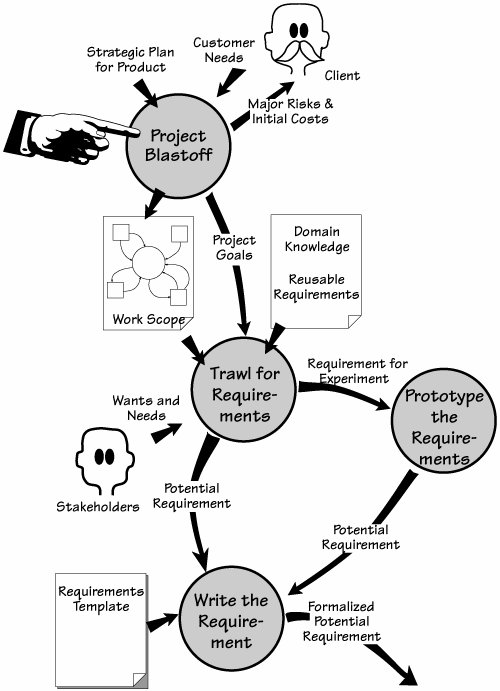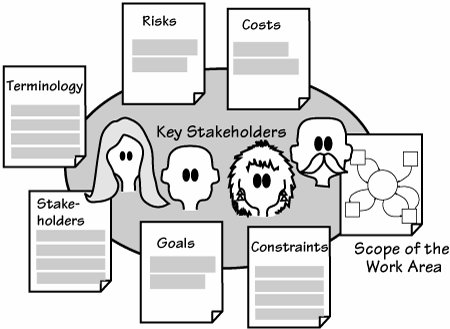in which we establish a solid foundation for the requirements, and ensure that the members of the project team all start rowing in the same direction The Project Blastoff is a burst of activity to launch a requirements project. It assembles enough information to get your project off to a flying start and to ensure it is viable and well founded. A blastoff might last a few hours or several daysit all depends on the size of the project and the amount of uncertainty. "The loftier the building, the deeper must the foundation be laid." Source: Thomas kempis |
The blastoff (see Figure 3.1) identifies the work area the product is to become a part of, and determines the purpose the product is to fulfill. It also identifies the stakeholders, who, it will turn out, are a vital ingredient to any requirements project. Other deliverables from the blastoff qualify the project and are used as inputs to subsequent requirements-gathering activities. Figure 3.1.
The blastoff activity lays the foundation for the requirements-gathering activities to come. You can find a complete model of the blastoff process in Diagram 1 of the Volere Requirements Process model in appendix A. 
You might know this activity as project kickoff, project initiation, or launch, among many other names. Whatever you call it, its purpose is to lay the groundwork so your requirements activity is efficient and effective. A number of deliverables result from the blastoff. Please look through the following list and consider those appropriate to your project. For each deliverable, look at its effect. Think of this outcome as payback for taking the time to collect or write it. The typical blastoff deliverables are as follows: Purpose of the project. This is a short, quantified statement of what the product is intended to do and what advantage it brings to the business. This purpose statement explains why the business is investing in the project along with the business benefit it wants to achieve. It justifies the project and serves as a focus as the requirements gathering proceeds. The scope of the work. The work is the business area affected by the installation of your product. You need to understand the work to specify the most appropriate product. The stakeholders. These people have an interest in the product. They include the clientthe person paying for the development of the product; the customerthe person or people who buy the product; the users who operate the product; and all the other people with some influence, or knowledge needed to gather the requirements for the product. Constraints. Are there any design solutions that must be used? How much time and money are available for the solution? Names. Is any special terminology used by this part of the organization? Relevant facts and assumptions (where applicable). Are there any special facts people need to know? Are assumptions being made that may affect the outcome of the project? The estimated cost. Deliverables from the blastoff provide input to the estimating process and help project management take advantage of the requirements as input to project planning. This is not really a requirements issue, but as the requirements deliverables are prime input, your project management will thank you for it. The risks. The deliverables may possibly include a short risk analysis to reveal the main risks faced by the project. Someone skilled at risk assess-ment should handle this analysis. A first-cut Low-Fidelity prototype. You might consider sketching a very quick mock-up of one of the major screens or features of the product. Taken together to (see Figure 3.2), these deliverables give you enough information to make the final deliverable from the blastoff: Go/no go decision. Is the project viable, and does the cost of producing the product make it worthwhile? Do you have enough information to proceed with the requirements activity, or should you ask for more time to learn more?
Figure 3.2.
The blastoff activity assembles enough information to ensure that the project can proceed smoothly. It also verifies that the project is viable and worthwhile. Most of the outputs build the foundation for the trawling activity to come. The risks and costs are used by project management. You can find a complete model of the blastoff process in Diagram 1 in the Volere Requirements Process model in appendix A. 
| 
